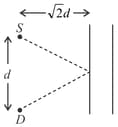Define constructive interference.
Important Questions on Waves and Sound
Four different independent waves are represented by
(i)
(ii)
(iii)
(iv)
With which two waves, interference is possible?
In interference, two individual amplitudes are units and units. Find
(a) (b)
A source and a detector are placed at a distance apart. A big cardboard is placed at a distance from the source and the detector, as shown in the figure. The source emits a wave of wavelength , which is received by the detector after reflection from the cardboard. It is found to be in phase with the direct wave received from the source. By what minimum distance should the cardboard be shifted away so that the reflected wave becomes out of phase with the direct wave?

Two waves, each having a frequency of and a wavelength of are travelling in the same direction on a string. the
(a) at the same place, if the second wave was produced after the first one then phase difference between the waves is .
(b) If the two waves were produced at the same instant but the first one was produced with a distance behind the second one then phase difference between the waves is .
(c) If each of the waves has an amplitude of then the amplitudes of the resultant waves in part (a) and (b) are .
Find .

